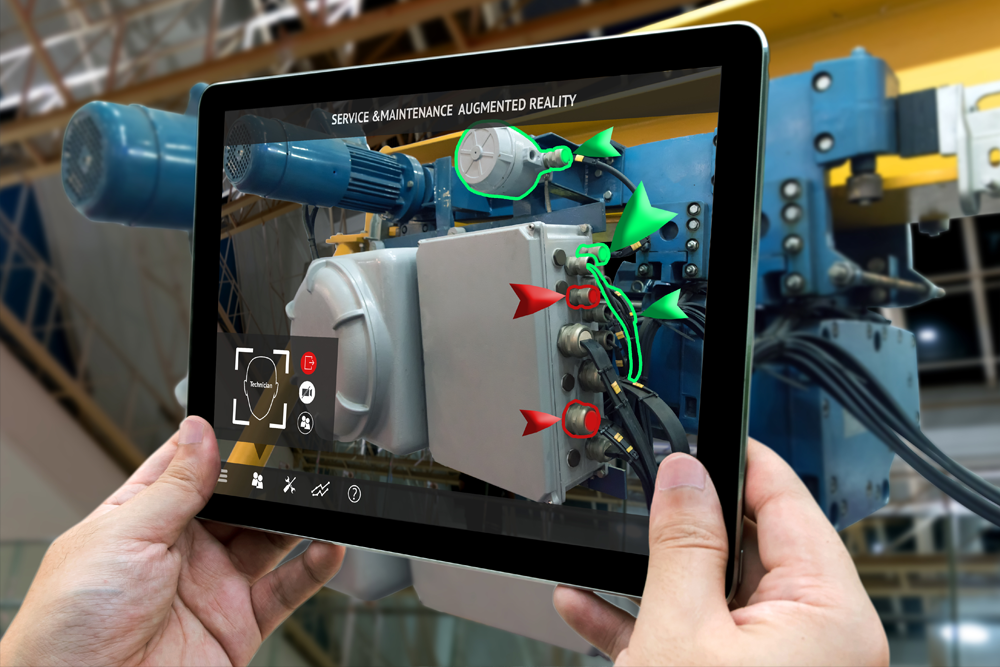9 Powerful Real-World Applications Of Augmented Reality (AR) Today
2 July 2021
The growth of augmented reality (AR) applications in recent years can be attributed to solutions that allow consumers to visualize products and imagine what it might feel like to own the product or experience the service before actually purchasing it. As augmented technology becomes more sophisticated and the cost-saving and business applications expand, the demand and investment in AR will increase. In 2017, ARKit was launched by Apple, and Google released ARCore for Android, both powerful tools for developers to create AR apps. It is predicted that there will be 1 billion augmented reality users by 2020. After a quick definition of augmented reality, let’s take a look at augmented reality that’s already used for real-world applications.

What is augmented reality (AR)?
When someone talks about AR, they are referring to technology that overlays information and virtual objects on real-world scenes in real-time. It uses the existing environment and adds information to it to make a new artificial environment. Many developers are creating augmented reality apps, and this has opened up the technology to many applications and a broader audience. If you’ve watched an American football game since 1998, you likely have seen the down line portrayed as a yellow line that moved down the field. That is an example of an augmented reality application. Have a look at this short video of me trying some leading edge AR tools.
Award-winning airport app
The Gatwick airport passenger app just won a number of awards for its creative use of AR technology. With the help of more than 2,000 beacons throughout its two terminals, passengers can use the AR maps from their mobile phone to navigate through the airport. As the app matures, it might eventually help improve traffic flow in the airport.
Ikea Place, Dulux Visualiser, and Lowe’s help remodel
For those who have purchased furniture and discovered once it was delivered it didn’t work in the space, the Ikea Place app will help you avoid that predicament in the future. The app was built using Apple’s ARKit technology, and it allows you to scan your room and design the space by placing Ikea objects in the digital image of your room to create a new environment with the new products.
The Dulux Visualiser helps you try out a shade of paint for your room before you buy. Just use your smartphone camera to scan your room and virtually paint it with any color of the rainbow.
Home improvement store Lowe’s has Measured by Lowe’s, a virtual tape measure that can be used inside and out, and Envisioned by the Mine (owned by Lowe’s) which allows you to place 3D images of furnishings and accessories into your home or commercial space.
Sephora Virtual Artist and Rolex
Cosmetic company Sephora uses AR technology to allow customers to try out different looks and eye, lips and cheek products as well as colors right on their own digital face. This is a powerful way to boost sales and to give customers a fun way to try out new looks. Another company that uses augmented reality to inspire purchases is Rolex. The company has developed a virtual try-on experience where prospective customers can try out different styles and models (this is me testing the app).
Augmented reality in healthcare
There are some incredibly exciting applications for augmented reality in healthcare from allowing medical students to train in AR environments to telemedicine options that enable medical professionals to interact with patients. In critical situations, augmented reality applications can deliver real-time information to the treatment area to support diagnosis, surgery and treatment plans. AccuVein is a handheld device that can scan the vein network of a patient that leads to a 45% reduction in escalations. Surgeons can plan procedures before making the first cut, models can be made of tumors, and AR diagnostic tools can model disease conditions. Deloitte Research asserts that AR will disrupt the business model and operations of healthcare.
AR for fun
Rather than increase sales, sometimes AR is just created for fun or to engage with customers such as the Bic DrawyBook app or teeth brushing games from Georgia-Pacific’s Dixie brand.
From gaming to construction to AR in browsers that provide detail for what the camera displays, augmented reality apps are being developed at a rapid pace to enhance many industries. As additional ideas get developed, we can expect augmented reality applications to touch many more aspects of our lives.
Related Articles
Will Quantum Computing Kill Bitcoin?
By now, “smart” versions exist of just about every home appliance, gadget and gizmos we can think of. However, manufacturers continue[...]
11 Most Reliable AI Content Detectors: Your Guide To Spotting Synthetic Media
Since the launch of ChatGPT just two years ago, the volume of synthetic – or fake – content online has increased exponentially.[...]
The AI-Powered Citizen Revolution: How Every Employee Is Becoming A Technology Creator
Something remarkable is happening in organizations around the world.[...]
6 Mistakes IT Teams Are Guaranteed To Make In 2025
The next wave of artificial intelligence isn't just knocking at enterprise doors - it's exposing fundamental flaws in how organizations approach technology transformation.[...]
2025’s Tech Forecast: The Consumer Innovations That Will Matter Most
Consumer technology covers all of the tech we buy to make our lives more convenient, productive or fun.[...]
7 Healthcare Trends That Will Transform Medicine In 2025
Healthcare has evolved dramatically in recent years, with technology driving countless new opportunities, just as demographic and societal factors have created new challenges.[...]
Sign up to Stay in Touch!
Bernard Marr is a world-renowned futurist, influencer and thought leader in the fields of business and technology, with a passion for using technology for the good of humanity.
He is a best-selling author of over 20 books, writes a regular column for Forbes and advises and coaches many of the world’s best-known organisations.
He has a combined following of 4 million people across his social media channels and newsletters and was ranked by LinkedIn as one of the top 5 business influencers in the world.
Bernard’s latest book is ‘Generative AI in Practice’.










Social Media